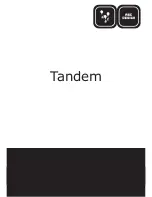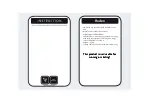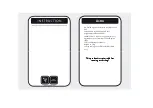
E
N
G
L
IS
H
35
Group 1 -
Only a limited number of people are authorised for use, and closure is not in a public area. Examples of this type are gates inside
business premises, where the sole users are employees, or a part of them who have been suitably informed.
Group 2 -
Only a limited number of people are authorised for use, but in this case, closure is in a public area. An example of this may be a
company gate that accesses onto a public street, and which is only used by employees.
Group 3 -
Anyone can use the automated closure, which is thus located on public land. For example the access gate to a supermarket or an
office, or a hospital.
Protection A -
Closure is activated by means of a control button with the person present, i.e. with maintained action.
Protection B -
With the person present, closure is activated by a command controlled by means of a key-switch or the like, in order to
prevent use by unauthorised persons.
Protection C -
Restricts the force of the leaf of the door or gate. I.e., in the case of the gate striking an obstacle, the impact force must fall
within a curve established by the regulations.
Protection D -
Devices, such as photocells, capable of detecting the presence of people or obstacles. They may be active on just one side or
on both sides of the door or gate.
Protection E -
Sensitive devices, such as footboards or immaterial barriers, capable of detecting the presence of a person, and installed in
such a way that the latter cannot be struck in any way by a moving leaf or panel. These devices should be active within the entire “danger
zone” of the gate. The Machinery Directive defines “Danger Zone” as any zone surrounding and/or near machinery where the presence of
an exposed person constitutes a risk to the health and safety of that person.
The risk analysis should take into consideration all danger zones for the automation device, which should be appropriately
protected and marked.
In a clearly visible area, apply a sign with information identifying the motorised door or gate.
The installer should provide the user with all the information relating to automatic operation, emergency opening and
maintenance of the motorised door or gate.
1.2 - TECHNICAL ASSISTANCE SERVICE
For any installation problem please contact our Customer Service at the 39-0172.812411 operating Monday to Friday
from 8:30 to 12:30 and from 14:00 to 18:00.
1.3 - EC DECLARATION OF INCORPORATION FOR PARTLY COMPLETED MACHINERY
(DIRECTIVE 2006/42/EC, ANNEX II-B)
The manufacturer V2 S.p.A., headquarters in Corso Principi di Piemonte 65, 12035, Racconigi (CN), Italy
Under its sole responsibility hereby declares that:
the partly completed machinery model(s):
ZARISS-M-230V
ZARISS-S-230V
Identification number and year of manufacturing: typed on nameplate
Description: electromechanical actuator for gates
• is intended to be installed on gates, to create a machine according to the provisions of the Directive 2006/42/EC.
The machinery must not be put into service until the final machinery into which it has to be incorporated has been declared in conformity
with the provisions of the Directive 2006/42/EC (annex II-A).
• is compliant with the applicable essential safety requirements of the following Directives:
Machinery Directive 2006/42/EC (annex I, chapter 1)
Low Voltage Directive 2006/95/EC
Electromagnetic Compatibility Directive 2004/108/EC
Radio Directive 99/05/EC
The relevant technical documentation is available at the national authorities’ request after justifiable request to:
V2 S.p.A., Corso Principi di Piemonte 65, 12035, Racconigi (CN), Italy
The person empowered to draw up the declaration and to provide the technical documentation:
Cosimo De Falco
Legal representative of V2 S.p.A.
Racconigi, 11th April 2010
Summary of Contents for ZARISS Series
Page 2: ......
Page 34: ...ITALIANO 32 ...
Page 66: ...ENGLISH 64 ...
Page 98: ...FRANÇAIS 96 ...
Page 130: ...ESPAÑOL 128 ...
Page 131: ......
Page 132: ......
















































